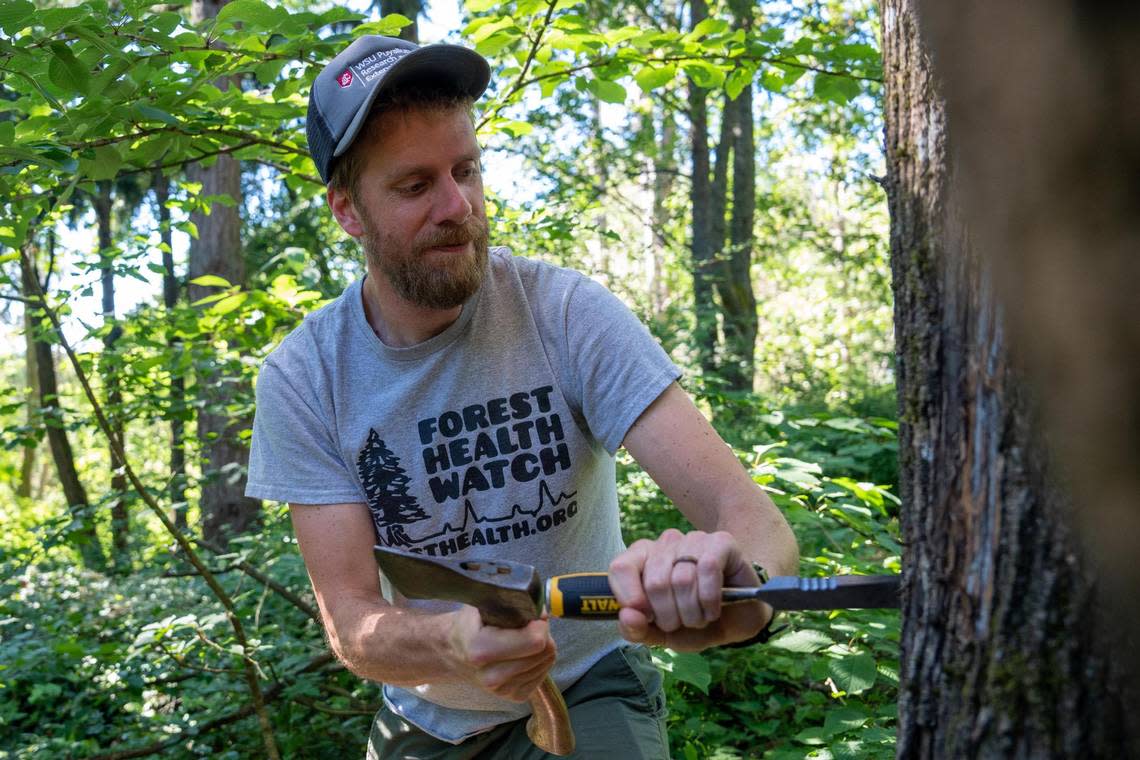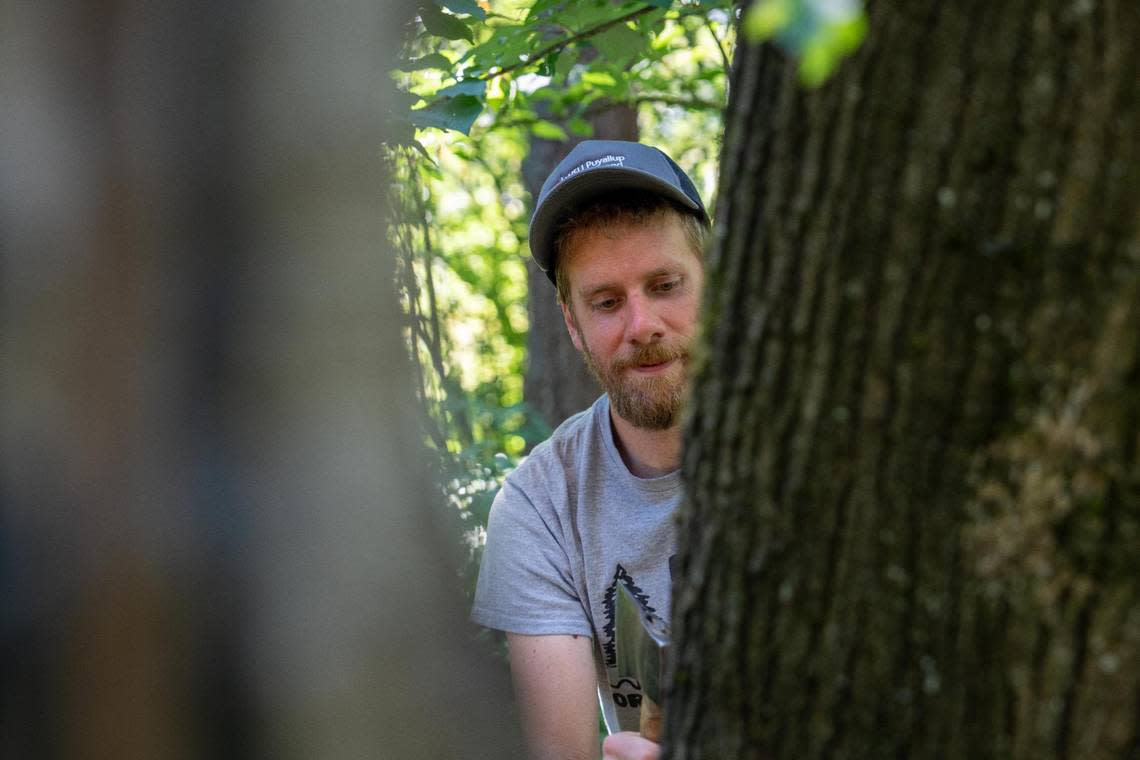Citizen scientists to study this tree disease found in Bellingham that can injure people
The list of diseases attacking trees in the Pacific Northwest grows every year. A pathogen now found in Bellingham brings an added concern: It can injure people.
A research project using citizen scientists starts this summer to track the spread of Sooty Bark Disease in Tacoma.

The disease is caused by a fungus, Cryptostroma corticale. Normally, the fungus grows in dead wood as part of the normal decaying process.
But the fungus has been increasingly found in living trees. The disease gets its name from the black patches that grow on the trunks of infected trees.
In a newly infected tree, branches become denuded and then die off. Eventually, the entire tree succumbs.
The fungus spreads by spores, and it’s those spores that can enter a person’s lungs and cause an allergic reaction called Maple Bark Disease.
In parts of Europe, tree fallers toppling infected trees are required to wear personal protection equipment to avoid the spores.
Where is it from?
It’s thought that Cryptostroma corticale is native to the Great Lakes region.
The fungus was found in Lewis County in 2007 and in King County in 2020 although a sample was found in Pullman in 1968, according to Washington State University researcher Joseph Hulbert.
Sooty Bark Disease was found in Bellingham, Olympia and Anacortes following the King County discovery.
Following the King County find, Hulbert also went looking for it in Pierce County. He didn’t have to go far from his home near Tacoma’s Franklin Park.
“We found it on a dog walk,” he said this week.
Researcher
On a hot summer afternoon this week, Hulbert led a pair of journalists to a grove of red maple trees in Franklin Park.
Hulbert, who has a Ph.D. in plant diseases, pointed to a jigsaw puzzle-like black patch, the fungus’ fruiting body, on one tree’s truck. Inches away are green moss and hair-like pale lichen. Both are harmless.

The fungus is not.
“It’s only a matter of time before the whole thing is dead,” he said, standing below the tree’s dying and dead branches.
Maples, he said, are Crypto’s favorite target, especially those in cities where heat can stress trees. Along with maples (both native and ornamental), the fungus targets horse chestnuts and native Pacific dogwoods.
“The hotter it gets, the more native trees are going (to die),” he said.
Could the disease be the cause of the mysterious bigleaf maple die-off?
“I don’t know if this is the answer,” he said. “At least in some parts, it’s explaining why trees are dying, but not everywhere.”
How it kills
Normally, living trees have natural chemicals that keep most fungi at bay. But climate change could be making trees more vulnerable, Hulbert said.
The fungus is thought to clog up a tree’s vascular system, depriving it of water and nutrients.
At first, the fungus grows stealthily, undetected, underneath a tree’s bark. Eventually, the bark falls off revealing the black patches.
There are some lookalike conditions, Hulbert said, but few that leave the characteristic black patches underneath the tree’s bark.
Still, a sample is confirmed through three methods:
▪ Spores are examined under a microscope.
▪ The fungus is grown in a petri dish.
▪ The genetic profile is established using polymerase chain reaction testing.
Study
The state Department of Natural Resources gave Hulbert and Washington State University’s Puyallup Extension and Research Center a $40,000 grant to study the disease in Tacoma. The funding is provided through the Evergreen Communities Act.
WSU is providing an additional $20,000 for the study.
Ben Thompson, who manages DNR’s urban and community forestry program, said a report from the study is due in June 2023.
Hulbert is looking for volunteers to become citizen scientists for the study. Potential researchers can sign up at a website, foresthealth.org/tacoma/.

WSU will provide training.
Hulbert is particularly interested in areas of Tacoma that have fewer trees and could be harder hit by the Sooty Bark Disease. He’s using data from heat mapping provided by Earth Economics to locate the hottest areas.
“How is this going to affect the areas that need trees the most?” he said.
When a potential case is reported to Hulbert, a sample will be taken with the owner’s permission.
The goal of the study is to track how widespread the disease is. There is no cure for it.
“There’s not really a ton that we can do,” Thompson said. “I think it’s folks like Joey Hulbert that are really doing the best work on this right now. As a scientist, he’s asking the questions and digging in.”
Maple bark disease
Hulbert doesn’t wear a mask when examining trees and said the general public needn’t worry about walking past trees.

When mature, the fungus releases clouds of airborne spores.
The state Department of Health says there’s a low risk of injury from breathing in airborne random spores. However, that risk increases substantially if an infected tree is cut or its wood is handled.
The spores can cause an allergic reaction if inhaled but not an infection. Called hypersensitivity pneumonitis, the disease is an inflammation of the airways or lungs.
The condition usually improves quickly when a person is no longer exposed to the spores.
